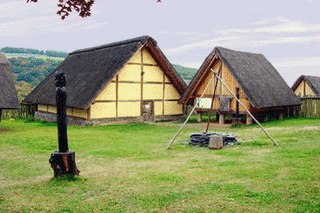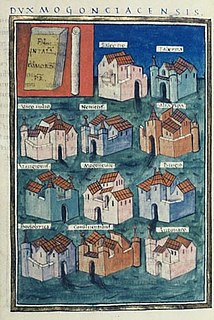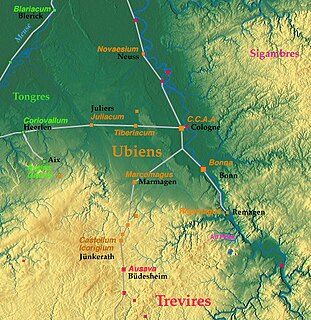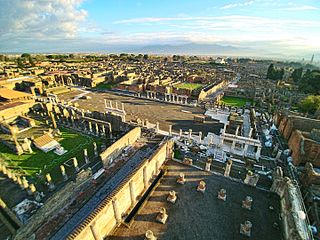This article concerns the period 19 BC – 10 BC.

Most of the city was destroyed in the bombing of Cologne in World War II, so it was of limited importance in post-war West Germany. It had returned to its pre-war population by 1959, by which time Düsseldorf was the political center of the state of North Rhine-Westphalia, and Bonn was the (provisional) capital of the Federal Republic. In the late 20th century, Cologne grew into a center of the sprawling Rhine-Ruhr metropolitan area, with some 12 million inhabitants, just over one million of whom live in Cologne proper, making the city the fourth largest in Germany.

Publius Quinctilius Varus was a Roman general and politician under the first Roman emperor Augustus. Varus is generally remembered for having lost three Roman legions when ambushed by Germanic tribes led by Arminius in the Battle of the Teutoburg Forest, whereupon he took his own life.

Marcus Cassianius Latinius Postumus was a Roman commander of Batavian origin who ruled as Emperor in the West. The Roman army in Gaul threw off its allegiance to Gallienus around the year 260, and Postumus assumed the title and powers of Emperor in the provinces of Gaul, Germania, Britannia and Hispania, thereby founding what scholars have dubbed the Gallic Empire. He ruled for the better part of ten years before he was murdered by his own troops.
Legio I Germanica, the 1st Germanic Legion, was a legion of the Imperial Roman army, possibly founded in 48 BC by Gaius Julius Caesar to fight for him in the civil war against Pompey. The title germanic is a reference to its service in Germany, rather than the place of origin of its soldiers. After the Revolt of the Batavi, the remaining men of the Germanica were added to Galba's seventh legion, which became VII Gemina. The emblem of Legio I is unknown, but it was probably Taurus, like all the other legions levied by Caesar.

Germania Inferior was a Roman province located on the west bank of the Rhine and bordering the North sea.

The Treveri or Treviri were a Belgic tribe who inhabited the lower valley of the Moselle from around 150 BCE, if not earlier, until their displacement by the Franks. Their domain lay within the southern fringes of the Silva Arduenna, a part of the vast Silva Carbonaria, in what are now Luxembourg, southeastern Belgium and western Germany; its centre was the city of Trier, to which the Treveri give their name. Celtic in language, according to Tacitus they claimed Germanic descent. Modern historians consider the Treveri to have been a mixed Gallic-Germanic tribe.

The Chamavi were a Germanic tribe of Roman imperial times whose name survived into the Early Middle Ages. They first appear under that name in the 1st century AD Germania of Tacitus as a Germanic tribe that lived to the north of the Lower Rhine. Their name probably survives in the region today called Hamaland, which is in the Gelderland province of the Netherlands, between the IJssel and Ems rivers.

The Vangiones appear first in history as an ancient Germanic tribe of unknown provenance. They threw in their lot with Ariovistus in his bid of 58 BC to invade Gaul through the Doubs river valley and lost to Julius Caesar in a battle probably near Belfort. After some Celts evacuated the region in fear of the Suebi, the Vangiones, who had made a Roman peace, were allowed to settle among the Mediomatrici in northern Alsace.. They gradually assumed control of the Celtic city of Burbetomagus, later Worms.

The Roman-Germanic Museum is an archaeological museum in Cologne, Germany. It has a large collection of Roman artifacts from the Roman settlement of Colonia Claudia Ara Agrippinensium, on which modern Cologne is built. The museum protects the original site of a Roman town villa, from which a large Dionysus mosaic remains in its original place in the basement, and the related Roman Road just outside. In this respect the museum is an archaeological site.

The Agri Decumates or Decumates Agri were a region of the Roman Empire's provinces of Germania superior and Raetia; covering the Black Forest, Swabian Jura, and Franconian Jura areas between the Rhine, Main, and Danube rivers; in present southwestern Germany, including present Frankfurt, Stuttgart, Freiburg im Breisgau, and Weißenburg in Bayern. The only ancient reference to the name comes from Tacitus' book Germania. However the later geographer Claudius Ptolemy does mention "the desert of the Helvetians" in this area.

Colonia Claudia Ara Agrippinensium was the Roman colony in the Rhineland from which the German city of Cologne developed.

For around 450 years, from around 55 BC to around 410 AD, the southern part of the Netherlands was integrated into the Roman Empire. During this time the Romans in the Netherlands had an enormous influence on the lives and culture of the people who lived in the Netherlands at the time and (indirectly) on the generations that followed.
Aulus Caecina Severus was a Roman politician and general who was consul in 1 BC. He was Emperor Augustus' representative in Moesia when the Great Illyrian Revolt broke out; he spent 4 years in heavy fighting before helping to suppress it. In 14 AD he was in charge of several legions on the lower Rhine which mutinied on the death of Augustus. He is recorded as having handled this poorly, with the situation only being salvaged by the intervention of his commander-in-chief.

The Ara trium Galliarum, or ‘Altar of the three Gallic provinces’, was a Roman sanctuary near Lugdunum. The altar was consecrated to the goddess Roma and Augustus.

Turicum was a Galloroman settlement at the lower end of Lake Zurich, and precursor of the city of Zürich. Situated within the Roman province of Gallia Belgica and near the border to the province of Raetia, there was a tax-collecting point for goods traffic on the waterway Walensee–Obersee-Zürichsee–Limmat–Aare–Rhine.
Titus Curtilius Mancia was a Roman senator, who held several offices in the emperor's service during the middle of the first century. He was suffect consul in the nundinium of November-December 55 as the colleague of Gnaeus Cornelius Lentulus Gaetulicus. No other senator with his gentilicium is known, so Mancia seems to have been a homo novus.



















